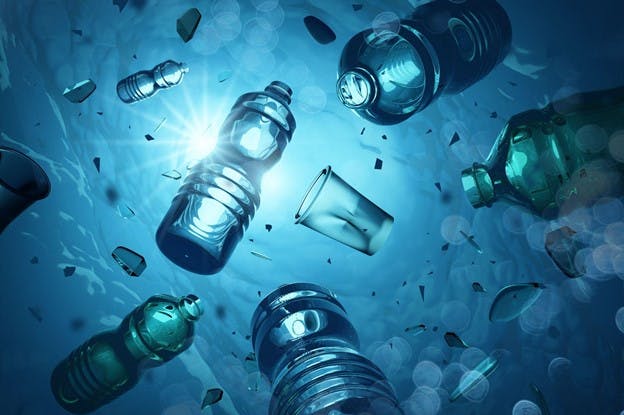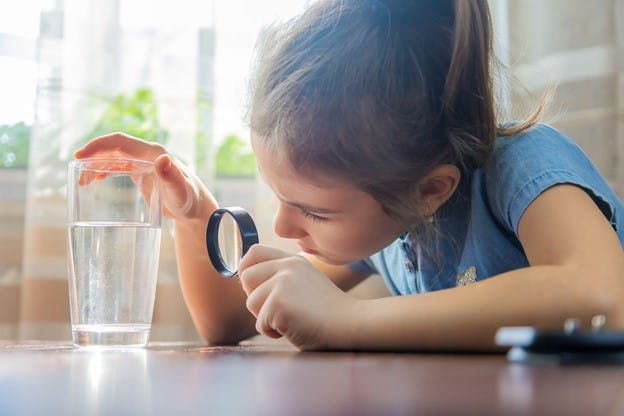January 2023
How to Protect Yourself From Microplastics in Water
We’ve all seen it. Plastic waste — mainly food packaging, bottles, and plastic bags — floating among natural debris in our shared marine environments. Many of us have made a conscious choice to live by the mantra of reduce, reuse, and recycle so as not to add to the problem. We’d never do something like throw a plastic bottle in the ocean, and we might even go out of our way to pick up a bottle or two and find the proper receptacle for it.
But did you know that the simple act of washing a load of laundry can put millions of plastic microfibers in our waterways? Or that your car tire racing over asphalt is releasing plastic particles into the air? Plastic is everywhere and we’re all using way more of it than we know.
Some estimates say the average person could consume — through ingestion and inhalation — the equivalent of one credit card worth of plastic per week. And we know very little about what that plastic does when it enters the human body or the public health impact it may have.
While there’s still a lot to learn about what these plastics do, plenty of concerned folks aren’t waiting for science to tell them this might be a problem to do something about it.
Today, we want to explore microplastics in water and try to understand what they are, what it means for human health, and what you can do to minimize your microplastic exposure.
What Are Microplastics?
Microplastics are pieces of plastic that are less than 5 millimeters in size. Some microplastic particles are manufactured for various purposes, while others come from the breakdown of larger plastic debris.
The really tiny particles are known as nanoplastics. These are even smaller particles that measure anywhere from 1 nanometer to 1 micrometer.
For context, a nanometer is one-billionth of a meter, while a micrometer is one-millionth of a meter. The width of a human hair is up to 100,000 nanometers.
Nanoplastics are usually not made on purpose. They are byproducts of other plastic production or they’re a product of degradation.
Where Do Microplastics in Water Come From?
The source of microplastics and other plastic pollution come from the many products we use every day. It may not surprise you to find out that mismanaged waste is the biggest source for microplastics in water. All those single-use plastic items and food packaging adds up. What might surprise you are all the other ways microplastics make it into the ocean.
A 2017 report showed the following seven primary sources for microplastics in our oceans:
Laundering clothes made with synthetic materials like polyester
- Tire dust from cars
- City dust
- Road markings
- Marine coatings
- Microbeads in personal care products
- Plastic pellets from plastic manufacturing and recycling
Most of the microplastics from items on this list come from weathering and abrasion over time that turns protective coatings and synthetic products into plastic particles and fibers. These particles are free to break off and find their way into our air, water sources, and food chain.
Are Microplastics Found in Drinking Water?
Yes, microplastics are found in drinking water.
In 2019, the World Health Organization had this to say about microplastics in water:
“Based on the limited information we have, microplastics in drinking water don’t appear to pose a health risk at current levels. But we need to find out more. We also need to stop the rise in plastic pollution worldwide.”
Are Microplastics in Drinking Water Harmful?
There are surprisingly few studies on the health risks of humans ingesting or inhaling microplastics. One of the reasons is it’s hard to figure out exactly how much plastic is in a water sample since there is no standardized testing for it yet.
There have been several animal studies that raise concern, like this study of tissue accumulation of microplastics in mice that have been exposed to microplastics. They found that the microplastics accumulated in the kidneys, liver, and gut of the mice. The particle size determined where in the body it accumulated. This accumulation led to disruptions in energy and fat metabolism, and it altered numerous biomarkers that indicate toxicity and neurotoxicity.
Other studies have shown reproductive problems in male mammals and shortened life expectancy in nematodes.
Are Microplastics Regulated in Drinking Water?
No. Currently there is no standardized way to test water for microplastics, which has made regulation a challenge.
In 2018, California passed a law that would make it the first government in the world to require municipal water suppliers to monitor microplastics. After years of researching testing methods, a four-year pilot program will begin in 2023.
They will have some of their water suppliers test their source water a few times per year and report their findings to the public. This four-year program will hopefully advance testing forward for everyone.
Environmental science is pointing toward plastic pollution having damaging health effects to our natural ecosystems, but reliable methods of testing are needed before regulation can happen.
Where Are Microplastics Found?
Microplastics are found everywhere in the world, from arctic snow to human placentas. They are in the water, our food, in plants, and even in the air.
Because plastics take so long to break down, the levels of microplastics in our environment continue to increase year after year.
Can Microplastics Be Removed From Water?
Yes. While it is difficult for drinking water treatment facilities to remove plastics — or even test for them — the right water filter can reduce microplastic pollution down to very small particle sizes.
The HomeWater EZChange 2-Stage Under Sink Filter for instance is able to greatly reduce microplastics, as well as chlorine, lead, sediment, VOCs (volatile organic compounds), particulates, heavy metals, mercury, chloroform, and cysts.
Can Your Body Get Rid of Microplastics?
If you’ve ever had a kid or a pet who has swallowed a toy, you probably know that larger pieces of plastic can pass through our digestive tracts. Smaller particles though can be absorbed through your intestinal wall and make a permanent home in your body.
Plastic accumulation in humans and wildlife is becoming a concern for many people as we learn more about the health effects.
Does Colgate Toothpaste Contain Microplastics?
Colgate toothpaste no longer contains microplastics.
In 2015, the U.S. Food and Drug Administration (FDA) passed the Microbead-Free Waters Act of 2015. This banned the use of microbeads smaller than 5 mm in all personal care products.
Prior to that, these tiny solid plastic beads were popular in all sorts of personal products because they were cheap to manufacture, they added bulk to the product, and they would work well for exfoliation and scrubbing.
Since the ban, personal care product companies in the U.S. have had to reformulate their products to not include them. Most products now use biodegradable alternatives like crushed nut shells and apricot kernels.
What’s the Problem with Microbeads?
Microbeads are small enough to pass right through wastewater treatment plants and go straight into our waterways. Once there, they are often mistaken as food by birds and fish and other aquatic life.
These beads are also very absorbent so they can pick up pollutants, which then contaminate the food chain all the way back up to humans.
In New York alone, over 19 tons of microplastic contamination went down the drain and into our waterways each year just from microbeads.
Does Boiling Water Remove Microplastics?
Boiling water will not remove microplastics from tap water or lower their concentrations.
As a tool for water treatment, boiling water works well for killing pathogens that could make you ill. It does not remove anything from the water that can’t turn into a gas. For that you would need some type of filtration.
The exception to this is if you use boiling to distill the water. Distillation is when you boil water and capture the steam that has separated itself from the contaminants.
How Can You Protect Your Family From Microplastics in Water?
Microplastics in water have been accumulating for over 100 years now and we really don’t know much about its impact. What we do know is plastic is everywhere and it doesn’t break down. Nano and microplastics are of particular concern because they find their way into everything, including your organs.
There’s no standardized testing for microplastics in water, and there are currently no regulations for the amount of these plastics in the water supply. However, the right kind of water filter can reduce microplastic pollution in your water.
HomeWater’s EZChange 2-Stage Under Counter Under Sink water filter uses two blocks to trap contaminants in your water supply before it flows through your taps. The NSF-certified filters significantly reduce microplastics in your water, as well as chlorine, lead, mercury, and other contaminants. With our easy-to-use self-installation kits, you can have your filters at work in just 15 minutes.
Learn more about how our products can protect you and your loved ones at HomeWater.


